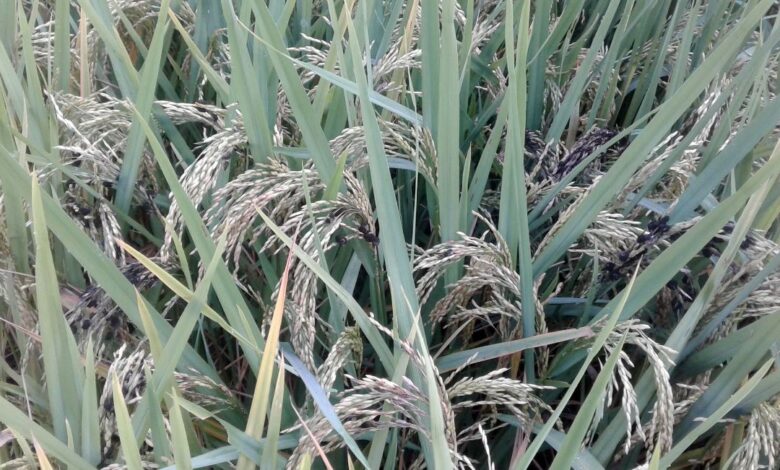Chickpea, also known as gram or Bengal gram, is a significant legume crop cultivated in many parts o ...
Jhulsaa Rog, commonly known as "Blast Disease," is a significant threat to rice crops worldwide. This fungal disease can cause severe damage to rice plants, leading to reduced yields and financial losses for farmers. Understanding the causes, symptoms, and management strategies of Jhulsaa Rog is crucial for maintaining healthy rice crops and ensuring a good harvest.
धान (चावल) भारत की प्रमुख फसलों में से एक है, और यह देश की खाद्य सुरक्षा का महत्वपूर्ण हिस्सा है। लेकिन धान की खेती में कई रोग और समस्याएँ आती हैं, जिनमें से एक प्रमुख रोग है "झुलसा रोग"। यह रोग धान के पौधों को बुरी तरह से प्रभावित कर सकता है, जिससे पैदावार में भारी गिरावट हो सकती है। इस लेख में हम धान के झुलसा रोग के बारे में विस्तार से जानेंगे, इसके लक्षण, कारण, और इसके नियंत्रण के उपायों पर चर्चा करेंगे।
झुलसा रोग धान की पत्तियों और तनों को प्रभावित करता है। यह रोग आमतौर पर दो प्रकार का होता है:
1.पत्ती झुलसा (Leaf Blast): इसमें धान की पत्तियों पर छोटे-छोटे भूरे या गहरे भूरे रंग के धब्बे बनते हैं, जो धीरे-धीरे बढ़ते हुए पूरी पत्ती को सुखा देते हैं।
2.गर्दन झुलसा (Neck Blast): इस प्रकार के झुलसा में धान की बालियों के निचले हिस्से पर संक्रमण होता है, जिससे पौधों की गर्दन झुलस जाती है और बालियाँ दाने नहीं बना पातीं।
झुलसा रोग का प्रमुख कारण Pyricularia oryzae नामक कवक (फफूंद) है। यह कवक धान के पौधों पर तेजी से फैलता है और पौधों को संक्रमित करता है। इसके प्रमुख कारण निम्नलिखित हो सकते हैं:
- अत्यधिक नमी और गर्म मौसम (20-30 डिग्री सेल्सियस)
- उचित वायुवीजन की कमी
- अधिक नाइट्रोजन का उपयोग
- जल जमाव की समस्या
- संक्रमित बीज का उपयोग
1. पत्तियों पर धब्बे:पत्तियों पर छोटे-छोटे धब्बे दिखाई देते हैं, जो बाद में बड़े होकर पूरी पत्ती को सुखा सकते हैं।
2. तनों का काला पड़ना:संक्रमित पौधों के तनों और गर्दन का हिस्सा काला पड़ने लगता है।
3. बालियों का न बनना:गर्दन झुलसा रोग के कारण धान की बालियाँ विकसित नहीं हो पातीं और पौधे में दाने नहीं बनते।

1. बीज उपचार:रोग रहित बीज का चयन करें और बीजों का कवकनाशी से उपचार करें।
2. संतुलित उर्वरक का उपयोग:अधिक नाइट्रोजन के उपयोग से बचें और संतुलित उर्वरक का उपयोग करें।
3. सिंचाई का उचित प्रबंधन:खेत में जल निकासी की उचित व्यवस्था करें, जिससे जल जमाव न हो।
4. जैविक नियंत्रण:ट्राइकोडर्मा जैसी जैविक कवकनाशियों का प्रयोग करें, जिससे कवक का विकास रोका जा सके।
5. रासायनिक नियंत्रण:जरूरत पड़ने पर योग्य कृषि विशेषज्ञ की सलाह लेकर उपयुक्त फफूंदनाशक दवाओं का छिड़काव करें, जैसे कि कार्बेंडाजिम, ट्राइसाइक्लाज़ोल, या एडिफ़िन।
धान में झुलसा रोग एक गंभीर समस्या है, लेकिन सही समय पर इसके लक्षण पहचानकर उचित कदम उठाने से इस रोग से फसल को बचाया जा सकता है। किसानों को चाहिए कि वे धान की खेती में जागरूकता बनाए रखें और रोग के प्रारंभिक लक्षणों पर ध्यान दें। सतर्कता और समुचित प्रबंधन से इस रोग से निपटने में सफलता मिल सकती है, जिससे धान की अच्छी पैदावार सुनिश्चित की जा सके।
1. Leaf Blast:This is the most common form of the disease. Infected leaves show small, grayish, or whitish spots with dark edges. These spots can enlarge and coalesce, causing the leaves to wither and die.
- Balanced Fertilization: Avoid excessive use of nitrogen fertilizers. Employ balanced fertilization strategies to promote healthy plant growth without making the plants too attractive to BPH.
- Water Management: Maintain proper water levels in the fields. Periodic draining of fields can disrupt the life cycle of BPH and reduce nymph survival.
- Planting Time: Adjusting the planting time to avoid peak BPH population periods can help minimize damage.
2. Biological Control:
- Natural Enemies: Encourage the presence of natural predators and parasites of BPH, such as spiders, lady beetles, and parasitic wasps. These biological control agents can significantly reduce BPH populations.
- Pathogens: Fungal pathogens like *Beauveria bassiana* can be introduced into the fields to infect and kill BPH nymphs and adults.
3. Chemical Control:
- Insecticides: Use of insecticides should be carefully managed to avoid the development of resistance in BPH populations. Systemic insecticides, which are absorbed by the plant and kill the hoppers as they feed, can be effective, but their use should be minimized and integrated with other control methods.
- Resistant Varieties: Planting BPH-resistant rice varieties can be an effective strategy, but it should be part of a broader Integrated Pest Management (IPM) approach to prevent the development of new BPH biotypes.
4. Monitoring and Early Detection:
- Regular monitoring of rice fields for early signs of BPH infestation is crucial. The use of light traps and pheromone traps can help in detecting BPH populations at an early stage, allowing for timely intervention.
0
0
Chickpea, also known as gram or Bengal gram, is a significant legume crop cultivated in many parts o ...
Mango is one of the most popular and widely cultivated fruits globally. However, mango trees are sus ...
The Brown Plant Hopper (BPH), scientifically known as Nilaparvata lugens, is one of the most notorio ...
Rice is a staple food for a large portion of the world's population, making its cultivation crucial ...
Rice (paddy) is one of the most vital staple crops in the world, feeding billions of people globally ...
Wheat is a staple crop grown globally, but it is susceptible to various diseases that can significan ...
Gardeners and farmers often rely on chemical pesticides to protect their plants from pests and disea ...